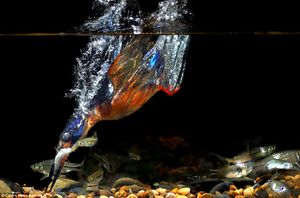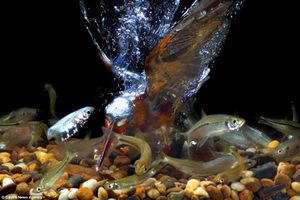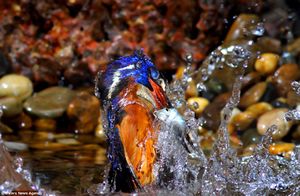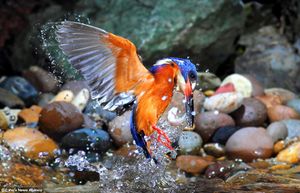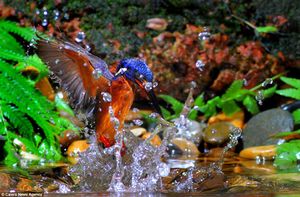الرفراف ذو الأذنين الزرقاوتين
| الرفراف ذى الأذنين الزرقاواتين | |
|---|---|

| |
| التصنيف العلمي | |
| مملكة: | |
| Phylum: | |
| Class: | |
| Order: | |
| Family: | |
| Genus: | |
| Species: | A. meninting
|
| Binomial name | |
| Alcedo meninting Horsfield, 1821
| |
الرفراف ذوالأذنين الزرقاوين ( ALCEDO meninting) عثر عليه في آسيا ، في المنطقة التي تمتد عبر شبه القارة الهندية و جنوب شرق آسيا. انها وجدت أساسا في الغابات الكثيفة الظل حيث يصطاد في مجموعات صغيرة. إنه ذو تاج قاتم , مع أجزاء سفلية ضاربة للحمرة والتي تفتقر إلى شريط الأذن الأحمر التى تشترك فيه الرفرافات المشتركة ( ALCEDO atthis) التي وجدت في البيئات الأكثر انفتاحا. وقد وصفت عدد من السلالات التي تختلف في قياس ولون الظل. الذكور البالغين لديهم bill داكنة في حين أن الإناث لديهم الفك السفلي انخفاض محمر .
. . . . . . . . . . . . . . . . . . . . . . . . . . . . . . . . . . . . . . . . . . . . . . . . . . . . . . . . . . . . . . . . . . . . . . . . . . . . . . . . . . . . . . . . . . . . . . . . . . . . . . . . . . . . . . . . . . . . . . . . . . . . . . . . . . . . . . . . . . . . . . . . . . . . . . . . . . . . . . . . . . . . . . . .
الوصف
هذا 16 centimetres (6.3 in) الرفراف الطويل هو مطابق تقريبا لالرفرافات المشتركة ( ALCEDO atthis) لكن يتميز بأغطية الأذن، الأكثر قتامة ووالجزء العلوى الأزرق المخضر أكثر كثافة مع أجزاء منخفضة ضاربة للحمرة . والرفراف الأزرق ذو أذنين الصغير له أغطية أذن ضاربة للحمرة كما في الرفراف الشائع ولكنه عادة ما يظهر بعض التبقيع على الحلق والجزء العلوي من الثدي الذي يختفي عندما يصل سن البلوغ . صغار الطيور لديها bill محمر مع .,زوائد علوية بيضاء.[2][3]
المجموعة من هذا النوع تمتد من الهند في الغرب ، شرقا عبر نيبال ، بوتان و بنجلاديش ، والى مزيد من ميانمار، تايلند ، كمبوديا، فيتنام و ماليزيا. للموئل المعتاد هو برك أو مجاري في الغابات الكثيفة دائمة الخضرة وأشجار المانغروف في بعض الأحيان، وتقع تحت من علو.
السلوك وعلم البيئة
والرفراف الأزرق ذو أذنين مقيمة إلى حد كبير في نطاقها. وعادة ما جثم على الفروع المتدلية تيارات المظللة المكتظة قبل الغوص أدناه لالتقاط الفريسة التي تشمل القشريات و اليعسوب اليرقات والأسماك. وقد سجلت غيرها من الحشرات بما في ذلك الجنادب وفرس النبي.[4]
موسم التكاثر في الهند هو أساسا مايو.-يونيو. في شمال الهند ويناير كانون الثاني في جنوب غرب الهند. العش هو نفق طوله في الضفة من تيار الغابة حيث وضعت حوالي 5-7 بيضاء بالقرب من مناطق وضع البيض الكروى.[2]
بعد دراسة التزاوج الطبيعي للحيوانات، والتغذية والمعيشة ودورة بناء الأسرة تم خلق استوديو داخل البرية وإنشاء بركة تغذية جديدة للطيور لتغذيتها وقد خلق عمل السيد سوانمون عاصفة بين مصورى الحياة البرية حيث أبدى المعجبين التعبير عن دهشتهم من أعماله ذات الجودة العالية وقال انه يأمل الآن إستخدام معرضه كمنصة لدفع تايلاند في صدارة التصوير الفوتوغرافي لدى العالم الطبيعي وقال: 'وقال هناك الكثير من الناس أن هذه هي المرة الأولى التي يروا فيها صورا من هذه النوعية، ويتوقعون حقا أن تلك اللقطات اتخذت من قبل مصورين غير تايلانديين'
مصور هاو قد إلتقط صورا جميلة بشكل مذهل لواحد من أروع الصيادين الطبيعين يعمل .
قضى فيفات سوانمون ، المصور التايلاندي الهاوى ، سنتين لتصوير الرفراف ذو الأذنين الزرقاوين في محاولة لتوثيق عاداته الغذائية غير العادية.
His striking photographs show a family of kingfishers diving into water to hunt.
The birds are so rare that many experts are awestruck that an amateur photographer managed to take the pictures at all.
Mr Suwanmon said: ‘It was important to allow the birds to see me often and build up trust in order to allow me to take their pictures while they act naturally - not an easy feat to get wild birds to do.
‘I spent ages among the birds and had to be extremely patient but I finally got to take pictures of this wonderful bird doing what it does best.’
The 33-year-old roped in his family to help him create a hide in the birds’ habitat in Thailand's southern province, Satun.
After studying the animals' natural mating, feeding and living cycle the family built a studio within the wilderness and created a new feeding pond for the birds to fish in.
The photographer then encouraged the birds to continue their natural hunting while he shot exceptional pictures.
He said: ‘It takes them about one second to catch a fish.
'They move so quickly that I had to try a variety of different methods to get the best shot.
‘But the pictures are definitely worth the hard work.’
Mr Suwanmon’s work has created a storm among wildlife photographers as admirers express their amazement of the high-quality work.
He is now hoping to use his gallery as a platform to propel Thailand to the forefront of natural world photography.
He said: ‘A lot of people said this is the first time they'd seen pictures of this quality and expected that they'd really been taken by a non-Thai photographer.
‘Hopefully this is only the start of the development of taking quality pictures, and I plan to take further series in the years ahead.’
الهامش
- ^ BirdLife International (2012). "Alcedo meninting". IUCN Red List of Threatened Species. Version 2012.1. International Union for Conservation of Nature. Retrieved July 16, 2012.
{{cite web}}: Invalid|ref=harv(help) - ^ أ ب Ali, S & S.D. Ripley (1983). Handbook of the Birds of India and Pakistan. Volume 4 (2 ed.). New Delhi: Oxford University Press. pp. 78–80.
- ^ Baker, ECS (1927). The Fauna of British India including Ceylon and Burma. Birds. Volume 4 (2 ed.). لندن: Taylor and Francis. pp. 254–258.
- ^ Becking, JH (1989). Henri Jacob Victor Sody, 1892-1959: His Life and Work. Brill Archive. p. 188.
وصلات خارجية
| Alcedo meninting
]].



